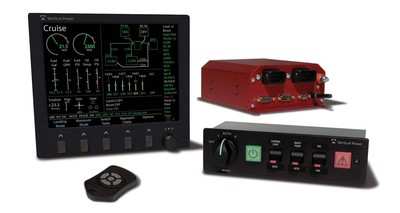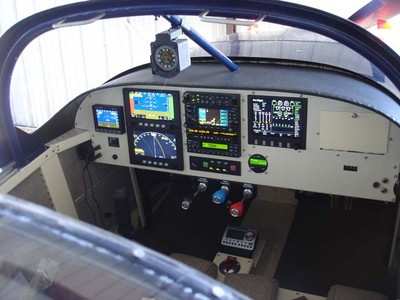Solid-State Intelligent Electrical Control System For
Experimental Aircraft, LSA
Vertical Power tells ANN the Albuquerque, NM-based company will
unveil its new VP-200 at AirVenture 2007. The VP-200 uses
microprocessors and solid-state switches to provide advanced
electrical system features, simplified aircraft wiring, and the
ability to eliminate dozens of modules, breakers and switches
typically found in modern aircraft.

The VP-200 is geared towards the experimental and light sport
aircraft.
"In the last five years or so there has been a very significant
shift in general aviation aircraft from mechanical systems to
all-electronic systems. Trim, flaps, EFIS, ignitions, and engine
monitoring functions have all gone electronic, yet the electrical
system in your aircraft is the same as it was 50 years ago," said
Marc Ausman, President of Vertical Power and an RV-7 builder/pilot.
"The electrical system is so much more important now and pilots
need more information and more options for electrical control.
Moving to the VP-200 is similar to aircraft navigation using a VOR
needle and then installing a GPS moving map. You can do it the old
way, but the new way gives you much better awareness and a lower
workload."
"Now that electronics are such an important part of
today’s aircraft, I see intelligent electrical control
systems as the next important advancement in general aviation
aircraft," said Gordon Pratt, VP of Business Development, Cobham
Avionics and Surveillance and member of the Vertical Power Board of
Advisors. "This is as significant as the change from round dials to
a synthetic vision system like the Chelton FlightLogic EFIS we
pioneered nearly a decade ago."
Representatives with Vertical Power tell ANN that during a
typical flight, the VP-200 has the ability to automatically track
various flight stages, each one representing a specific "mode" of
ground or flight operations. For each mode (Pre-Flight, Before
Start, Start, After-Start, Taxi, Run-Up, Takeoff, Cruise, Maneuver,
Landing, and Post-Flight) the pilot can:
- define which electrical devices (lights, radios, pumps, etc.)
are automatically turned on and off,
- configure the presentation of the engine instruments to
optimize and de-clutter the display,
- specify a checklist that appears when switching into a
particular mode.
On the ground, the pilot pre-configures the VP-200 to match the
way he flies and the way he wants the system to operate. For
example, the VP-200 can be configured to turn on the landing lights
and boost pump automatically in Takeoff and Landing modes. The
run-up checklist can be set to appear when a run-up is performed.
The pitch trim system can be set to be less sensitive above a
pre-configured air speed.

In addition to the mode-based switching, the pilot has full
manual control over the electrical system and can turn each
electrical device on and off individually, either with "soft keys"
on the display or with external switches. The pilot can also see
the real-time status of the electrical system on a graphic display,
similar to what is found on newer business and commercial jets.
"The VP-200 handles many of the routine tasks that a pilot
performs on every flight so the pilot can spend more time looking
outside the cockpit and focus on flying the airplane," said Kevin
DeVries, Vice President of Engineering at Vertical Power. "The
VP-200 is designed to be very fault tolerant and allows the builder
to incorporate numerous backups if desired."
In addition to full electrical device control, a few of the
features include:
- a wireless key fob that can turn on and off electrical devices,
including the cabin lights and can perform a check of the exterior
lights,
- visual and aural alerts when a circuit fault occurs, including
protection for short circuits, over-current, over-voltage, and
under-voltage conditions,
- visual and aural alerts when engine parameters exceed
limits,
- automatic pitch trim biasing when flaps are lowered, and
variable speed pitch trim,
- runaway trim & flap protection with backup controls and
audible gear and flap warnings,
- configures the trim and flaps after engine start and engine
shutdown,
- user-configurable flap behavior with adjustable intermediate
stops,
- landing lights can flash/wig-wag,
- alerts when a landing light burns out,
- alerts when the mag switch is set incorrectly,
- timed shut-off of the master switch after engine shutdown.
Vertical Power says the VP-200 also includes a new and safer way
to handle emergencies. By pressing the red emergency button on the
VP-200, and selecting from a list of emergencies shown on the
display (alternator failure, electrical fumes, engine failure, and
engine fire,) the component then executes a pre-configured set of
actions.
For example, if the primary alternator fails, with two button
presses the system begins load shedding, switches to the backup
alternator and brings up the alternator failure checklist.

Aircraft wiring is also simplified using the VP-200. The builder
simply runs wires from the VP-200 to each electrical device such as
a radio, transponder, landing light, flap motor, or battery
contactor. Switches, circuit breakers, diodes, mechanical relays,
complex bus architectures, and various modules are mostly
eliminated. In contrast to a switch and circuit breaker panel that
requires mechanical or electrical modifications to support changes,
the VP-200 can be configured using setup menus. This allows the
system to be configured for the wide range of designs found among
experimental aircraft and allows future changes to be made very
easily.
Future software upgrades can be downloaded from the Vertical
Power web site and installed via a USB port.
The VP-200 integrates with most engine monitors, such as the
Electronics International MVP-50, Grand Rapids Technologies EIS,
Advanced Flight Systems AF-3400/3500EE, and Dynon FlightDEK-D180.
Additionally, it can integrate with most GPS and EFIS systems
including the Chelton EFIS & GADAHRS, Garmin G900X, Garmin
430/530/480, and Grand Rapids Technologies EFIS.
Vertical Power will launch the new VP-200 and VP-200 Duo
(supports dual independent electrical busses) systems at EAA
Airventure 2007, which runs from July 23-29 in Oshkosh, WI. The
VP-200 retails for $6,495 and the VP-200 Duo retails for $9,995,
and will begin shipping in August 2007.
 ANN's Daily Aero-Linx (05.06.25)
ANN's Daily Aero-Linx (05.06.25) ANN's Daily Aero-Term (05.06.25): Ultrahigh Frequency (UHF)
ANN's Daily Aero-Term (05.06.25): Ultrahigh Frequency (UHF) ANN FAQ: Q&A 101
ANN FAQ: Q&A 101 Classic Aero-TV: Virtual Reality Painting--PPG Leverages Technology for Training
Classic Aero-TV: Virtual Reality Painting--PPG Leverages Technology for Training Airborne 05.02.25: Joby Crewed Milestone, Diamond Club, Canadian Pilot Insurance
Airborne 05.02.25: Joby Crewed Milestone, Diamond Club, Canadian Pilot Insurance




